Irish Legends, Myths and Gods
Irish mythology is rich and complex, with lots of different Celtic gods and goddesses featured in stories and folklore.
It can be difficult to keep on top of all the different characters – that’s because the Celtic people were polytheistic, meaning they worshipped multiple gods. In fact, it’s thought that they worshipped as many as 300 different gods! We know about many of these from sources that date back to Celtic times, including statues, ancient places of worship and engravings, as well as place names and personal names. Each of the gods worshipped by the Celtic people are linked to different aspects of life and the world around them.
Many of these Celtic gods and goddesses feature in mythology. Originally Celtic mythology was passed down orally, but the stories were later written down – largely by Christian scribes, who modified the tales in line with their own religion. However, this written work means that Celtic mythology has been preserved to this day, and we have a good understanding of the different themes and deities in the stories.
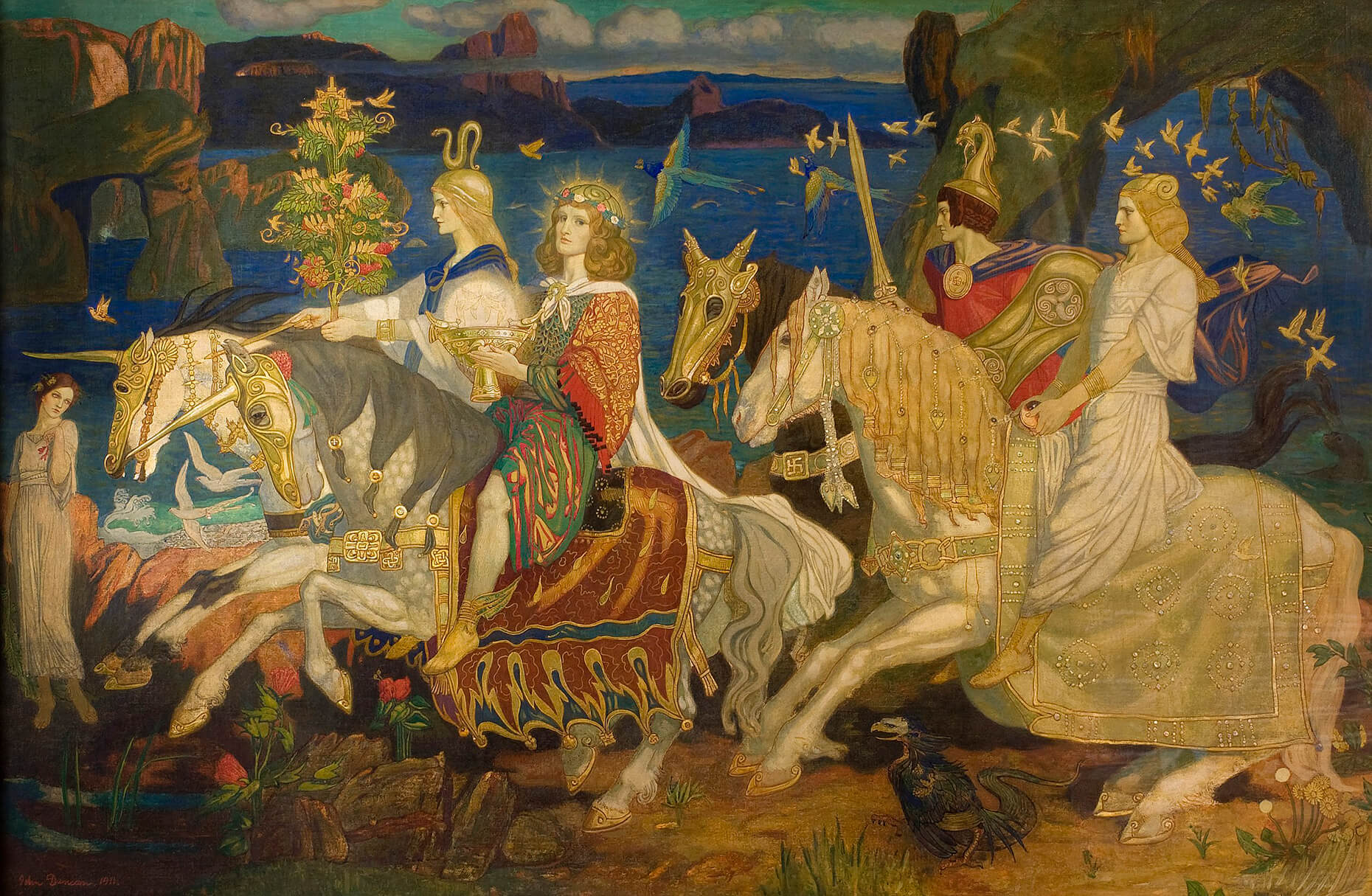
Celtic mythology can largely be divided into four different cycles:
- The Mythological Cycle, which includes stories and poems about the god-like Tuatha Dé Danann, who inhabited the island of Tír na nÓg
- The Ulster Cycle, which includes heroic tales from the ancient kingdom of Ulaid
- The Fianna Cycle, which is all about the mythical hero Finn and his warriors known as the Fianna
- The Kings’ Cycle, which includes historical tales about previous kings of Ireland
So, without further ado, let’s take a closer look at the different Celtic mythology goddesses and gods you need to know about.
Key Celtic deities you need to know about
It’d be impossible to cover every single Celtic god and goddess in one short article, but there are some characters who appear over and over again in Irish mythology. Here are some of the main names to look out for.
Morrigan
The Celtic goddess Morrigan is the goddess of war. She’s also sometimes known as ‘Morrigu’, or as the ‘Queen of Demons’ or the ‘Phantom Queen’. The Morrigan sometimes appears as a single entity, and at other times is described as a trio of sisters.
The Morrigan foretells doom or victory in battle, and usually appears as a crow when telling the fate of wars. It’s believed that her appearance as a crow would either inspire or frighten warriors, leading them to their eventual fate in battle.
She is a member of the Tuatha Dé Danann, the wife of Dagda and the daughter of Ernmas.
Brigid
The Celtic goddess Brigid is the goddess of fire, healing, agriculture, prophecy and poetry. It’s said that she was much loved by poets, and she is considered to be a wise sage.
Like Morrigan, she may be a Celtic triple goddess, as it’s sometimes said that she has two sisters, Brigid the healer and Brigid the smith.
Brigid is also a member of the Tuatha Dé Danann. She is the daughter of Dagda, the wife of Bres and the mother of Ruadán.
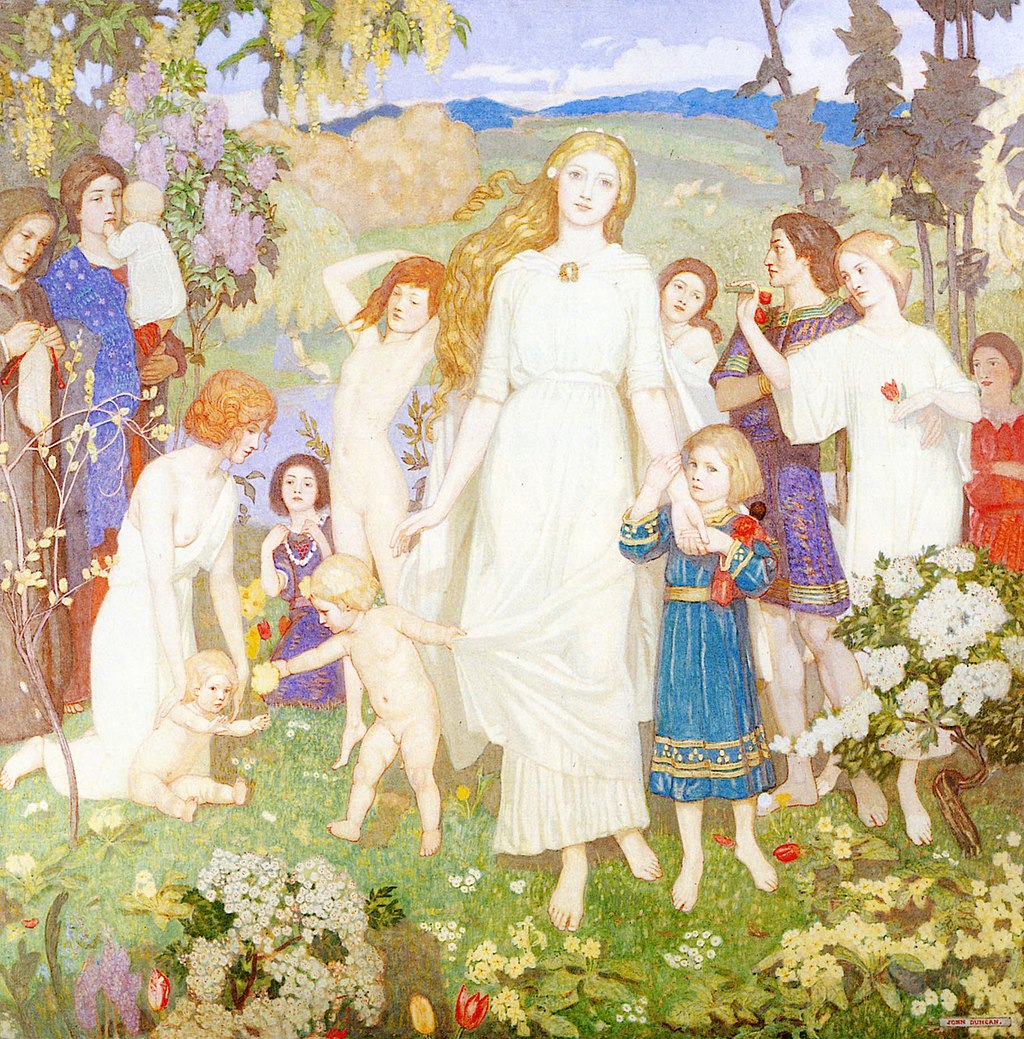
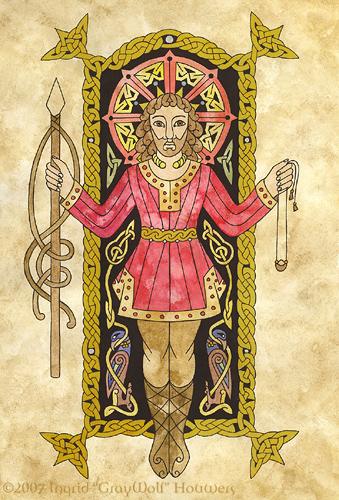
Lugh
Lugh, the Celtic god, is another member of the Tuatha Dé Danann, and a warrior. As well as a skilled warrior, he’s portrayed as a king, a saviour and a master craftsman, and stories about Lugh highlight his skilled mastery of all of his different disciplines.
He’s sometimes called Lámfada, which translates as ‘long hand’ or ‘long arm’, and is likely to relate to his skill with a spear. He is also occasionally known as Samildánach, translating to ‘equally skilled in many arts’, which highlights how he was a master of multiple disciplines.
Danu
The Celtic goddess Danu is known as the mother of Irish gods. She is the mother goddess of the Tuatha Dé Danann – in fact, these supernatural beings take their name from Danu, as the name Tuatha Dé Danann translates to ‘the peoples of the goddess Danu’. That means that all members of the clan descend from Danu, but despite her importance in Irish mythology, her own origins are unclear.
She is strongly associated with nature, as well as regeneration, wisdom, death, and prosperity. It’s thought that she passed on her own wisdom to members of the Tuatha Dé Danann, as well as her creative and crafty talents.
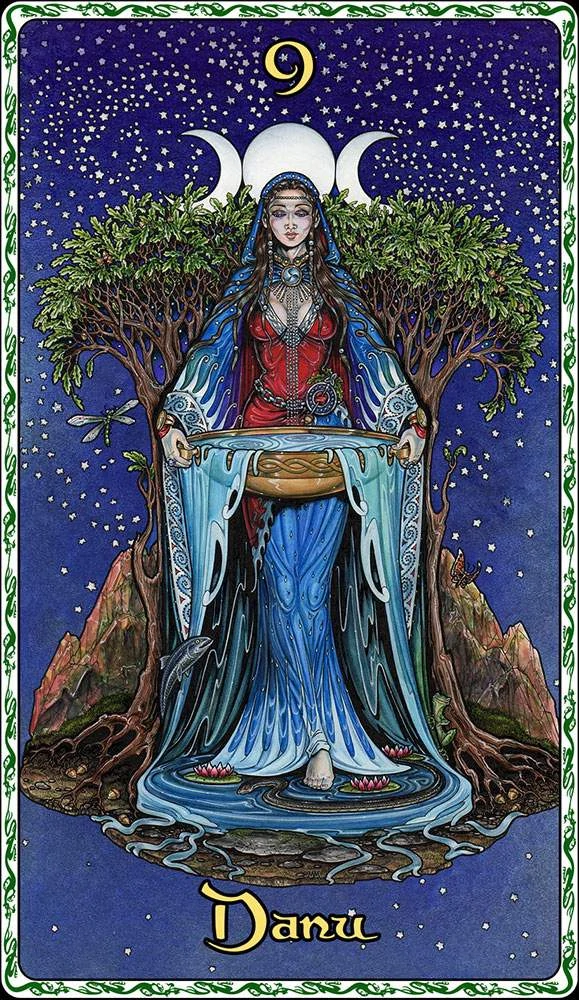
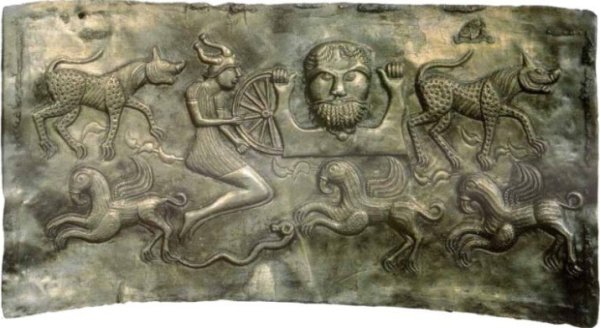
Taranis
Gundestrup cauldron, created between 200 BC and 300 AD, is thought to have a depiction of Taranis on the inner wall of cauldron on tile C
Taranis, also known in Irish mythology as Tuireann, is the Celtic god of thunder, who is easily recognisable by his sacred wheel, which stands for how quickly a storm could catch humans out. He’s also known for wielding a thunderbolt as a weapon.
Cernunnos
Cernunnos, also known as the Horned One, is a powerful Celtic deity who is the ‘lord of wild things’. He is usually shown with antlers, and is often seated in a cross-legged position. He’s closely associated with stags, dogs, bulls and horned serpents, and is almost always shown wearing a torc, a metal band which signified one’s status in Celtic society. He is sometimes also shown holding a bag of coins and a cornucopia.

Dagda
The Celtic god Dagda is sometimes known as the ‘good god’. He’s the god of the earth and the leader of the Tuatha Dé Danann. Dagda is portrayed as a father-figure, as well as a king and a druid, and is usually depicted as a giant bearded man who wears a hooded coat. According to Irish mythology, he had a magic staff or club which could both kill and bring life, depending on which end was used – and it’s said that he could kill ten men with just one blow.
Dagda is linked to fertility, agriculture and strength, along with wisdom, magic and druidry.
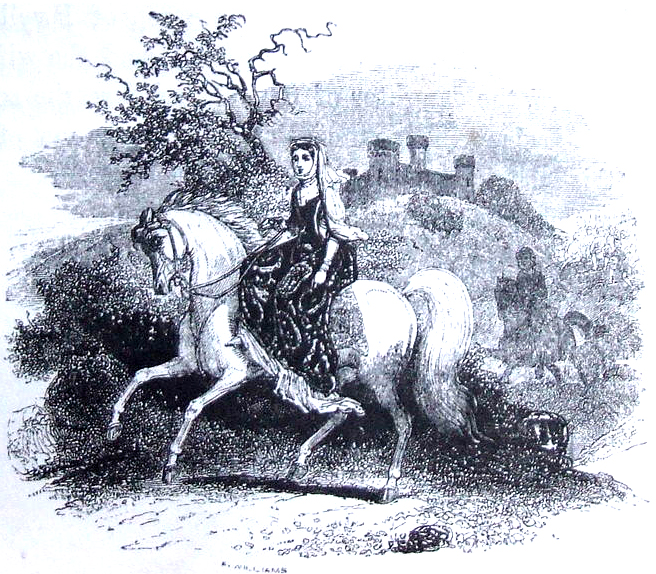
Rhiannon
Rhiannon, the Celtic goddess, is a symbol of fertility, but she also stands for rest, communication, and leadership. Sometimes called the goddess of the moon, it’s sometimes said that her name translates to ‘divine queen of the fairies’.
Macha
Macha the Celtic goddess represents life, death and war – and it’s usually said that she’s one of the Celtic triple goddesses associated with Morrigan. She’s also the goddess of the land, and is commonly associated with horses.
As the goddess of war, legend has it that Macha would feed on the heads of her enemies after defeating them in battle. As a mother goddess, there are usually three parts associated with Macha: a maternal reproductive element, an agrarian element, and an element of sexual fertility.
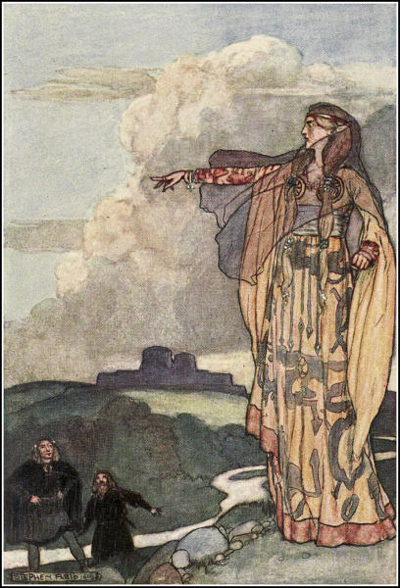
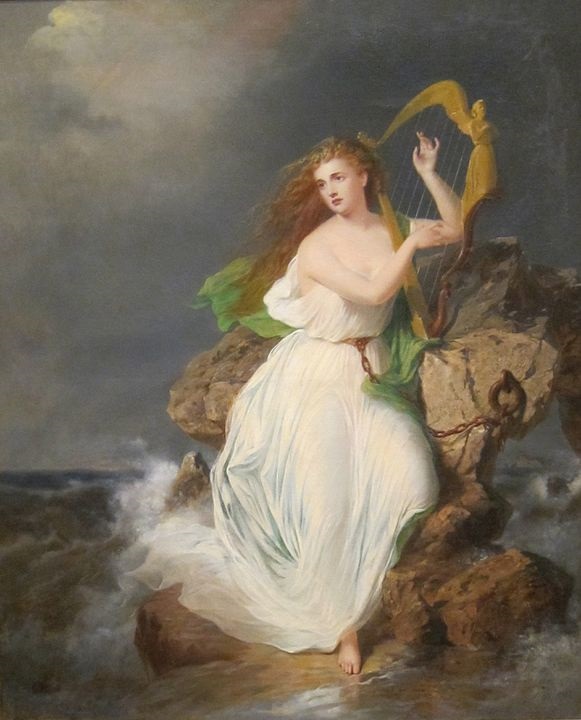
Eriu
‘The Harp of Erin’ by Thomas Buchanan Read
The Eriu goddess is the goddess of Ireland itself. She’s the goddess of fertility, abundance and sovereignty, and her name translates to ‘fullness’, ‘bounty’ or ‘abundance’. She was a member of the Tuatha Dé Danann, and is the sister of Banba and Fódla. The trio of sisters were married to three brothers, and it’s said that the three sisters asked that all of their names be given to Ireland. The name ‘Ireland’ is directly taken from Eriu, but Banba and Fódla are sometimes used as poetic names for the country.
Celtic mother goddesses
Aine
Aine, the Celtic goddess of love, summer, youth, wealth and sovereignty, is associated with midsummer, the sun, animals and agriculture. She has strong ties to Country Limerick, and even has a hill named after her, Kockainey (Cnoc Áine in Irish). On the hill, rites were carried out in her honour.
Aengus
Aengus, the Celtic god of youth and love, is a member of the Tuatha dé Danann and the son of Dagda and the river goddess Bionn. Also known as Aengus Óg (Aengus the Young), he is known for his good looks and witty wordplay, both of which helped him to win battles against his elders.
In Irish mythology, his youth allows him power over life and death, including the power to resurrect the dead. He is also a shapeshifter, and he had the ability to transform kisses into birds.
Arawn
Arawn, Celtic god of death, has origins in Welsh mythology in which he is the ruler of Annwn, the Celtic afterlife. He may also be a Welsh version of the Celtic god Arubianus. He has an imposing presence, depicted as a tall, looming figure on a grey horse which, along with his association with death, means that he’s sometimes mistaken for an evil god – but Annwn is depicted as a peaceful haven.
Epona
Epona, the Celtic goddess of fertility, is a protector of horses – indeed, her name is derived from the Celtic word ‘epos’ which means ‘horse’. She is often seen with symbols of fertility such as a cornucopia and patera.
Cerridwen
The Celtic goddess Cerridwen is the goddess of rebirth, inspiration and transformation. She is a Welsh goddess rather than an Irish one, and is sometimes considered as a sorceress rather than a goddess. She has a magic cauldron that can brew life-changing potions, and also has shape-shifting abilities.
Celtic gods and goddesses, by their powers
As you can see, the Celtic gods and goddesses each have specific powers or associations, from being responsible for war to controlling the seasons. Here you can find a list of Celtic god names, grouped by their powers.
Celtic war gods
The main Celtic gods of war are:
- Morrigan
- Neit
- Badb
- Macha
Celtic water gods
There are several Celtic gods and goddesses of the sea, including:
- Brigid
- Boann, the goddess of the River Boyne
- Danu
- Manannán mac Lir, the Irish sea god
- Lí Ban, water goddess
- Lir, another Celtic god of the sea
- Sinann, goddess of the River Shannon
Celtic gods of death and healing
Dian Cécht and Nodens are gods of healing, and Airmid is a Celtic goddess of healing, while Morrigan is a Celtic death goddess and Don and Arawn are Irish gods of death.
Celtic fertility goddess
Most of the deities associated with fertility are goddesses, but there is one notable exception in Cernunnos, the horned god associated with fertility, animals and nature. Celtic fertility goddesses include:
- Brigid
- Damara
- Damona
- Epona
- Nantosuelta
- Onuava
- Rosmerta
Celtic moon deities
The main Celtic moon goddess is Cerridwen, while Elatha is sometimes thought of as a Celtic moon god.
Celtic sun god
Lugh is the main Celtic sun god, representing the sun and light, while Áine is the goddess of summer, often associated with the sun so she could also be considered a Celtic sun goddess.
Celtic winter deities
The main deity associated with winter is Cailleach, goddess of the winter months who is said to control the weather.
Celtic forest god
Cernunnos, also known as the lord of the wild things, is the Celtic god of the forest.
Celtic god of fire
There are several Celtic gods and goddesses associated with fire, including:
- Brigid, goddess of fire, arts, crafts and poetry
- Aed, whose name translates as ‘fire’
- Grannus, Celtic god of fire and health
- Nantosuelta, goddess of fire, nature and fertility
Celtic god of lightning
Taranis is the god of lightning in Irish mythology.
Celtic horse goddess
There is no Celtic horse god in Irish mythology, but Epona is well-known as the Celtic goddess of horses.
Celtic cat goddess
There is no specific Celtic cat goddess, but the goddess Ceridwen was accompanied by white cats who carried out her orders on earth.
Celtic god of archery
The main Celtic archer goddess is Flidais, also a goddess of cattle and fertility, who was known for her beautiful hair.
Celtic gods of the hunt
There are several Celtic gods associated with hunting, including:
- Arawn, a Welsh Celtic deity associated with hunting, dogs and stags
- Cernunnos, the horned god associated with both hunting and fertility
- Nodens, linked to hunting, the sea, dogs and healing
Celtic god of the underworld
There are several gods and goddesses associated with the underworld in Celtic mythology, including the Welsh deity Arawn; Aed, the prince of the Daoine Sidhe; and Cerridwen, the goddess of the underworld, as well as the goddess of rebirth and transformation.
Celtic goddess of protection
Macha, alongside being the goddess of death, war and sovereignty, is also associated with protection in times of both war and peace.
Who were the Tuath Dé Danan?
Several of the Celtic deities on this list have been mentioned as members of the Tuath Dé Danan. But who were they? A supernatural race in Irish mythology, most of the clan were gods or goddesses possessing magical powers.
It’s said that they were banished from heaven because of their extensive knowledge, and they arrived in Ireland in a cloud of mist. They lived in the Otherworld, but often interacted with humans in the human realm.
The Tuath Dé Danan included kings, queens, warriors, healers, heroes, craftsmen, bards and poets, all of whom were extremely skilled and knowledgeable, and their members included some of the most important Celtic gods and goddesses. Notable members of the group include Dagda, also known as ‘the great god’; Morrigan, known as the ‘great queen’ or ‘phantom queen’; and Danu, mother of the gods.
FAQs about Irish gods
Still got questions about Celtic deities? Here are our answers to some of the most prominent Irish gods and goddesses.
Who is the main Celtic god?
Dagda is the leader of the Celtic gods. It’s often thought that other gods are based on him, because he embodied the most desirable Irish traits.
How many Celtic gods are there?
Irish mythology includes mention of over 400 different Celtic gods and goddesses.
Who is the Celtic equivalent of Odin?
Odin is the main god in Norse mythology, known as the god of war and of poets. In Celtic mythology, the closest equivalent is Dagda.
Are there Celtic demigods?
Demigods are part human and part god, often the offspring of a deity and a human. There are two main demigods in Celtic mythology: Cú Chulainn, who is the son of the god Lugh and a mortal woman named Deichtine; and Diarmuid Ua Duibhne, son of the god Donn, who is one of the Fianna.
Get in touch with your Irish roots
Are you fascinated by Celtic gods and goddesses? Do you want to find out more about Irish mythology? Whether you have Irish roots or you’re simply interested in the history and culture, why not become a Lord or Lady of Ardmore? With Celtic Titles, you can get your own piece of land on the Celtic Titles Nature Reserve in Slievekirk Wood near Derry? You’ll have your very own piece of Irish history, and will be helping to preserve this beautiful land for many more generations to enjoy.
What you should do next...
- Browse our plots to claim your title of Lord or Lady of the Ardmore
- Add any extra gifts and accessories, inspired by Irish traditions
- Receive your gift pack in the post and enjoy!
